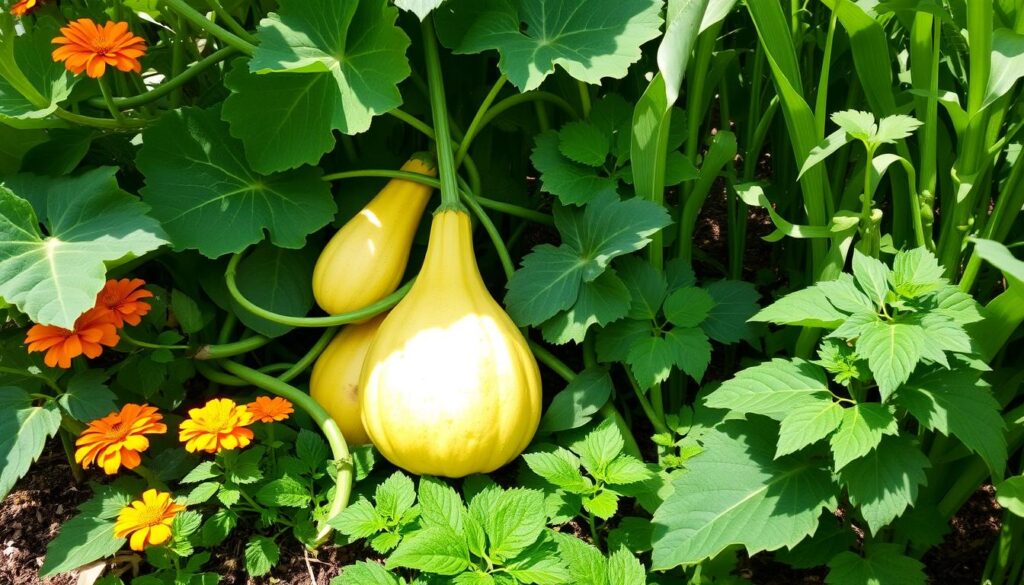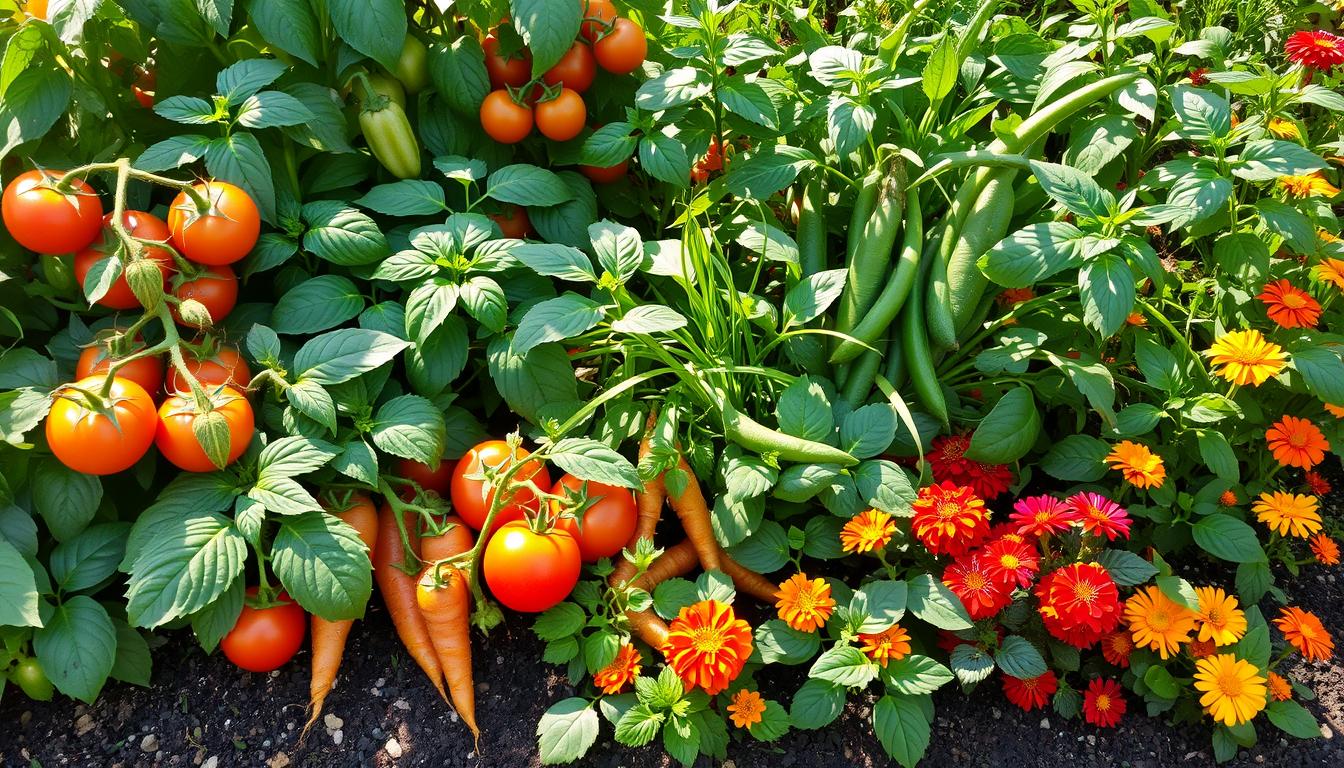Companion planting is a smart gardening trick. It involves placing certain plants next to others to boost growth and keep pests away. In this guide, we’ll look at the top plant pairings for common veggies. This knowledge helps your garden grow better and stay healthy with less work.
Key Takeaways
- Companion planting is a natural and effective way to enhance vegetable garden productivity
- Certain plant pairings can increase yields, deter pests, and promote overall plant health
- Understanding the benefits of companion planting can help you create a balanced and self-sustaining garden ecosystem
- Incorporating a diverse range of companion plants can improve the overall health and resilience of your vegetable garden
- Choosing the right companion plants for your favorite vegetable varieties is key to achieving optimal growth and harvest
Understanding the Benefits of Companion Planting
Companion planting brings many benefits to your garden. By placing certain plants together, you can boost vegetable yields, plant health, and natural pest control. This organic method can change how you grow your favorite foods.
Increased Yields and Healthier Plants
Some plants help others take in more nutrients. Others act as living mulch or support. This makes your garden better for growth, leading to plenty of harvests and strong plants. Companion planting lets you grow more without using chemicals.
Natural Pest and Disease Control
Companion plants attract good bugs that eat pests, cutting down on chemical use and offering natural pest control. Some plants even keep pests away, protecting your veggies. This way, your plants stay healthy and strong against bad weather.
Using companion planting makes your garden self-sustaining and productive. It needs little care but gives lots of food. Try it and see your garden grow and change.
“Companion planting is like a symphony of plants, each one playing its part to create a harmonious and productive garden.”
Tomato Companions: Enhancing Flavor and Growth
As a passionate gardener, I’ve found the amazing benefits of tomato companion plants. These plants not only make my tomatoes taste better and grow stronger. They also keep pests and diseases away.
Basil is one of my favorites. It smells great and keeps aphids and other pests away from my tomatoes. Marigolds are also excellent. They release a scent that keeps nematodes and other pests out of the soil.
Nasturtiums attract beneficial insects like ladybugs and lacewings. These insects eat pests that harm tomatoes. Chives and borage can even make tomatoes taste better and smell amazing.
To make my tomatoes grow even better, I plant them with asparagus, carrots, or parsley. These plants help my tomatoes stay healthy and productive. This leads to a big and tasty harvest.
“Companion planting is a time-honored tradition that can transform your tomato harvest. By thoughtfully choosing the right plants to grow alongside your tomatoes, you can create a thriving, pest-resistant, and flavorful garden.”
If you grow tomatoes, or are just starting, try tomato companion plants. The right plants can make your tomatoes grow better and taste amazing.
Cucumbers and Their Ideal Planting Partners
Cucumbers are a refreshing and versatile vegetable. They thrive when planted with the right companion plants. These pairings can improve your cucumber crop’s growth, health, and pest resistance.
Radishes: The Cucumber’s Guardian
Radishes are an excellent choice for cucumbers. They grow quickly and help loosen the soil. This makes it easier for cucumber roots to spread.
Radishes also keep cucumber beetles away. Beetles can harm your cucumber plants. So, radishes act as a natural guard.
Marigolds: Deterring Pests Naturally
Marigolds are another great companion for cucumbers. These flowers repel pests like aphids. Aphids often target cucumber plants.
By planting marigolds around cucumbers, you create a natural barrier. This protects your cucumbers from pests.
Cucumbers also do well with dill, nasturtiums, or sunflowers. These plants offer support, shade, and pest control. They help keep your cucumber garden healthy and productive.

Choosing the right companion plants can make your organic cucumber garden thrive. It reduces the need for harmful chemicals. Enjoy a bountiful harvest of fresh, flavorful cucumbers.
The Best Companion Plants for Popular Vegetable Varieties
Companion planting is a smart way to make your vegetables grow better. It can improve their taste and health. This method works well with many vegetables, like tomatoes, cucumbers, beans, carrots, and brassicas.
It helps your garden grow stronger and more balanced. Some plants keep pests and diseases away. Others make the soil better and help plants get the nutrients they need.
We’ll look at the best plants to pair with common vegetables. This will help your garden grow well and be full of life. You’ll learn how to make your favorite vegetables thrive.
Tomatoes and Their Ideal Companions
Tomatoes are a favorite in many gardens. They do well with the right plants nearby. Basil is great because it makes tomatoes taste better and keeps pests away.
Marigolds are also good. Their smell keeps nematodes and other pests from harming tomatoes.
Cucumbers and Their Ideal Planting Partners
Cucumbers grow best with certain plants. Radishes are excellent because they grow fast and keep cucumber beetles away. Marigolds also help by keeping spider mites and other pests off cucumbers.
| Vegetable | Ideal Companion Plants | Benefits |
|---|---|---|
| Tomatoes | Basil, Marigolds | Enhances flavor, deters pests |
| Cucumbers | Radishes, Marigolds | Loosens soil, deters pests |
Knowing which plants to pair with vegetables can make your garden better. You’ll see how to choose the best plants for your garden. Keep reading for more tips on pairing vegetables.
Beans: Nitrogen-Fixing Allies for Your Garden
Beans are a key part of any organic garden. They’re not just good to eat; they also help your garden grow strong. Beans fix nitrogen in the soil, which is great for other plants.
Corn and Beans: The Three Sisters Tradition
The “Three Sisters” method is a famous way to garden. It involves growing beans, corn, and squash together. This method was used by many Indigenous cultures.
The beans fix nitrogen, which helps the corn and squash grow. The corn gives the beans something to climb on. The squash spreads out, keeping the soil moist and weeds away.
- Beans enrich the soil with nitrogen, supporting the growth of corn and squash.
- Corn offers a natural trellis for the climbing bean plants.
- Squash covers the ground, shading out weeds and retaining soil moisture.
Using the Three Sisters method, gardeners can create a healthy ecosystem. This approach not only gives a big harvest but also keeps the soil healthy and pests away. It’s a smart way to grow beans organically.
Carrots and Their Complementary Companions
Gardeners aiming to boost their carrot crops should think about companion planting. Pairing carrots with the right plants can keep pests away and improve flavor and growth.
Radishes are a top choice for carrots. They grow quickly and help carrots grow straight. Radishes also confuse carrot flies, which helps protect your carrots.
- Radishes: Deterring carrot flies and improving soil structure
- Chives: Repelling aphids and enhancing carrot flavor
- Rosemary: Providing natural pest control and drought resistance
Chives are another great match for carrots. They keep aphids away and add a savory taste to carrots. For natural pest control, try marigolds or nasturtiums. They act as living mulch and keep pests off carrots.
“Companion planting is a time-honored tradition that can yield bountiful results for the organic carrot gardener.”
Choosing the right optimal carrot pairings can make your garden thrive. It will benefit from natural pest control for carrots and organic carrot gardening. Try different carrot companion plants to see what works best for you.
Brassicas and Their Protective Partners
Growing brassica crops like cabbage, broccoli, and kale can be very rewarding. But, these plants can face pests and diseases. Luckily, the right companion plants can act as a natural shield. Planting herbs around your brassica beds is a great way to do this.
Herbs as Companion Plants
Herbs like rosemary, thyme, and sage are perfect for brassicas. They can keep pests like cabbage worms, aphids, and flea beetles away. Their strong smells confuse and repel these pests, protecting your brassica crops.
Herbs like marigolds and nasturtiums also improve soil quality. They attract beneficial insects that eat brassica pests. This makes your garden healthier and more productive.
Using herbs as companion plants is key in organic brassica gardening. It helps control pests naturally and ensures your brassica companion plants grow well. By adopting these companion planting for cabbage and broccoli methods, you’ll enjoy a rich harvest of healthy brassicas.
“Companion planting is like a natural insurance policy for your garden – it helps protect your plants from pests and diseases while promoting overall plant health.”
Potatoes and Their Underground Buddies
Potatoes are a key crop in many gardens. They do well with the right potato companion plants. Plants like marigolds, horseradish, or catnip help keep pests away and improve potato health.
Horseradish: A Powerful Ally
Horseradish is a strong underground vegetable companion for potatoes. It keeps potato beetles and other pests away. This makes your potatoes healthier and more vibrant.
Horseradish also makes potatoes taste better. Its strong scent and taste balance out the earthy flavor of potatoes. This makes for a more enjoyable dish.
For those who garden organically, adding horseradish to your potatoes is smart. It keeps your garden healthy and chemical-free.
“Horseradish is a true champion when it comes to protecting potatoes from pests and diseases. Its powerful aroma and underground growth make it an ideal companion plant for potatoes.”
Squash: Maximizing Space with Companion Planting
Squash plants grow big and spread out, making them hard to fit in small gardens. But, by picking the right squash companion plants, gardeners can make the most of their space.
Planting beans or cucumbers with squash is a smart move. These vines can climb up the squash, saving space. The squash leaves also shade the beans and cucumbers, helping them grow better.
Companion planting also helps squash fight pests. Herbs like marigolds and nasturtiums keep pests away. Borage attracts good bugs that eat the pests.
For organic gardening, use radishes or buckwheat as living mulch. They keep the soil moist, stop weeds, and improve soil quality.
Pairing squash with the right companion plants makes a garden that’s efficient with space. It boosts yields, keeps pests away, and makes plants healthier. It’s a great way to use every inch of your garden.

Conclusion
Companion planting is a smart way to make your vegetable garden better. It lets you understand how different plants work together. This way, you can make a garden that grows well and needs less care.
Pairing plants like tomatoes and cucumbers or beans, carrots, and brassicas can help a lot. They can make your plants grow more, taste better, and fight off pests without chemicals.
Using organic gardening techniques means you get a lot of food while keeping your garden healthy. This method makes your garden better for growing things and keeps pests away naturally.
Keep trying out new companion plant pairings as you learn more. This way of gardening makes your garden grow strong and full of life. You’ll see your garden flourish and enjoy the fruits of your labor.



Leave a Reply